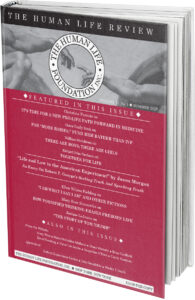GEN C (clusters of cells)
The Greatest Generation (b. 1901 to 1927) earned its name for fighting WWII. The Silent Generation (b. 1928 to 1945)—aka the Traditionalist Generation—produced the “Silent Majority,” who refrained from publicly expressing their thoughts on “sex, religion, and politics.” The term was popularized by Richard Nixon in 1969 when he said in a televised speech: “So tonight, to you, the great silent majority of my fellow Americans, I ask for your support,” referring to those who did not join in the demonstrations against the Vietnam War or embrace the counterculture. Yet, from this “traditionalist” and “silent” generation emerged the civil rights movement, the sexual revolution, and rock and roll! It would appear that societal conflicts are nothing new, except today they’re based on pure politics (encouraged by politicians) and of course abortion.
Baby Boomers (b. 1946 to 1964) were so named for being the largest generation, the high birth rate fueled by soldiers returning home and a post-war economic boom that provided plenty of food, optimism, and low stress—excellent conditions for starting or expanding a family. The generation-naming trend began with the Lost Generation (b.1883 to 1900), those who reached early adulthood during WWI. First used to describe a group of American expatriate writers living in Paris during the 1920s—Gertrude Stein is credited with coining the term—it was subsequently popularized by Ernest Hemingway in his 1926 novel The Sun Also Rises: “You are all a lost generation,” referring to the “disoriented, wandering, directionless” spirit of many of the survivors of the horrific war where mustard gas was first used.
These generations earned their descriptive nicknames for what they did, how they were, their noteworthy number. But now we have Gen X, Millennials, Gen Z, Gen A (Alpha), and next year’s yet unborn Gen B (Beta). No adjectives, just call letters and a calendar event (Millennials), and all of them, it seems to me, assigned right out of the gate.
A recent newspaper article predicted that Betas, like their X, Millennial, Z, and A forbears, will have their own set of distinctive styles and behaviors. Sure, the Lost Generation had the Roaring Twenties flapper, the Greatest had Art Deco, and the Boomers and Silents bell-bottom chic. But these were footnotes, not the zeitgeist itself. You’re not lost or great or booming based on your furniture or what’s hanging in your closet. Behavior? The identities of the Lost and the Greatest were forged by their reactions to the world; the Boomers’ by the world’s reaction to its size. Are there specific behaviors attributable to Gens X, Millennial, Z, and A? Hmm. Let’s see. They’re computer cognoscenti and insufferably smug about it! But seriously, if these generations do have a personality specific to them it’s not going to be described by a single, dry-as-dust letter. And since B hasn’t even been born yet, who’s to say there will be anything distinctive? There could be of course, but shouldn’t one wait to see how they turn out before labeling them? So, what’s the real reason for sterile letters instead of juicy adjectives?
Perhaps it’s a commercial mass marketing scheme. Identify them with a letter and then build an advertising campaign for clothes, sneakers, video games, etc., around it. Or political mass marketing, your letter linking you to this or that party. However opportunistic, that would at least indicate industriousness. But I fear it’s something more dreary.
The current trend of categorizing generations alphabetically began with Gen X (how descriptive!), which lands in the 1965 to 1980 range and saw, if you’ll pardon an awkward choice of words, the birth of abortion. The mandate that nationalized offspring-offing was the Supreme Court’s 1973 Roe v. Wade decision. But energetic advocacy for abortion debuted in 1967, at the Mayflower Hotel in Washington, D.C., during a NOW (National Organization for Women) membership conference when journalist Laurence Lader and abortionist Bernard Nathanson, who together founded NARAL (National Abortion Rights Action League), convinced Betty Friedan and other influential women that abortion was a magic potion for ensuring female autonomy. Once that thinking took hold, pregnancy and giving birth moved out of the “cycle of life” realm and into a “choice” arena that reduced baby making to a menu item. What could be more trivializing? By extension the next generations, instead of being unique and shaped by their times, became . . . the next batch. Their identity reduced to a cluster of cells; their development wholly dependent on how someone chose to regard them—if inconvenient, inconsequential. Potentially forever anonymous and forever faceless, so okay to just assign them a sterile letter right out of the gate rather than wait for a juicy adjective. Personally, I’d be pissed.
A signature phrase in the pro-life movement is Respect Life. A positive first step towards respecting life is admiring life. Maybe generations X through B will eventually take much deserved umbrage at how abortion culture has disrespected them, and forge a new individuality for themselves, and a better future for all of us.










